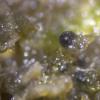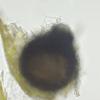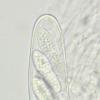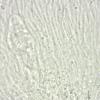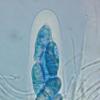
07-01-2026 17:29
 Marc Detollenaere
Marc Detollenaere
Dear Forum,On a barkless Populus I found some smal

10-11-2021 17:33
 Riet van Oosten
Riet van Oosten
Add-on topic http://www.ascofrance.com/forum/7059

07-01-2026 10:24
 Danny Newman
Danny Newman
Pezicula sp. on indet. hardwood Appalachian Highl

07-01-2026 10:05
 Danny Newman
Danny Newman
cf. Chaetospermum on XylariaCosby Campground, Grea

02-01-2026 17:43
MARICEL PATINOHi there, although I couldn't see the fruitbody, I

04-01-2026 17:45
 Stephen Martin Mifsud
Stephen Martin Mifsud
I was happy to find these orange asmocyetes which

03-01-2026 13:08
Niek SchrierHi all,We found groups of perithecia on a Lecanora
Bryostroma
Elisabeth Stöckli,
16-09-2024 14:20
Sur une pierre recouverte de mousse (forêt de montagne à 2'000m), périthèces piriformes avec une petite papille, 0.15 - 0.25 mm de diamètre, ascus bituniqué, avec huit pores, IKI-, 120 - 150 x 20 - 25 µm, spores verruqueuses, hyalines, à deux cellules, 20 - 32 x 8 - 10 µm. Ces caractéristiques me font penser à B. popei, sauf que mes spores sont plus larges. Qu'en pensez-vous ? Merci d'avance pour vos avis.
Elisabeth
Georges Greiff,
22-09-2024 20:50
Re : Bryostroma
Dear Elisabeth,
Excellent find and documentation as always. This does indeed seem to be a Bryostroma. It will be important to identify the host. The type species, B. racomitrii, is possible, though it should have a mixture of 8- and 4-spored asci. B. axillare is also close. All the known species are in the B. popei paper key.
But there are likely many undescribed species around. I have one on Racomitrium fasciculare with 4-spored asci but much smaller spores than B. racomitrii, so it must be something new. But the collection was too small!
All the best,
George
Excellent find and documentation as always. This does indeed seem to be a Bryostroma. It will be important to identify the host. The type species, B. racomitrii, is possible, though it should have a mixture of 8- and 4-spored asci. B. axillare is also close. All the known species are in the B. popei paper key.
But there are likely many undescribed species around. I have one on Racomitrium fasciculare with 4-spored asci but much smaller spores than B. racomitrii, so it must be something new. But the collection was too small!
All the best,
George



